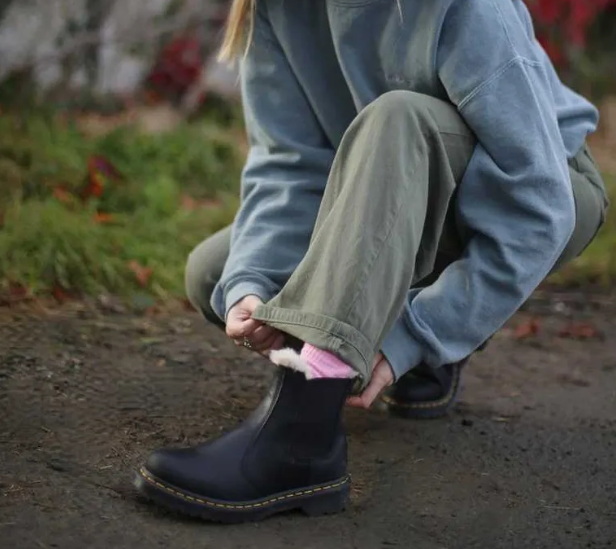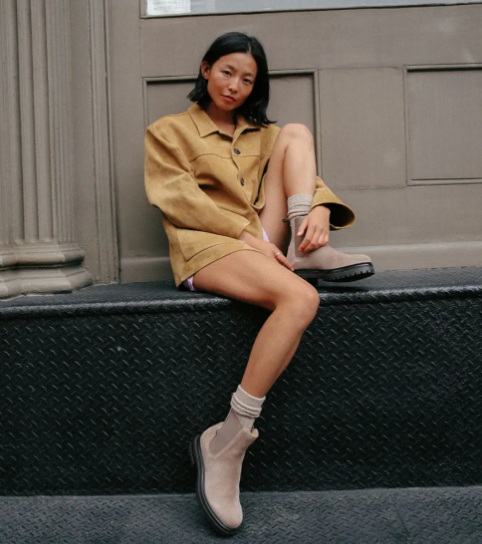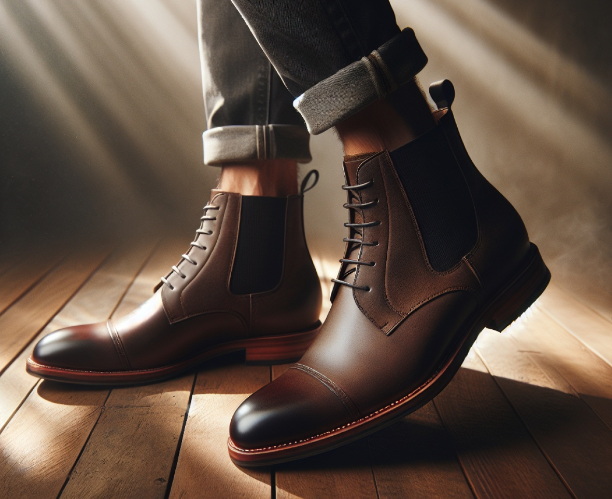Content Menu
● The Importance of Ankle Fit
● Key Elements of a Proper Fit
● How to Check for the Right Fit
● Sizing Considerations
● Material and Construction
● Addressing Common Fit Issues
● Styling Tips
● Conclusion
● FAQ
>> 1. How do I know if my Chelsea boots are too tight around the ankle?
>> 2. Can Chelsea boots be stretched to improve the ankle fit?
>> 3. What type of socks should I wear with Chelsea boots to ensure a comfortable ankle fit?
>> 4. How should the elastic side panels of Chelsea boots feel around the ankle?
>> 5. Are there specific Chelsea boot styles that offer a more accommodating fit around the ankle?
● Citations:
Chelsea boots are a versatile and timeless footwear choice, loved for their sleek design and adaptability to various styles[6][7]. A crucial aspect of ensuring both comfort and style when wearing Chelsea boots is achieving the right fit, particularly around the ankle[1]. This article delves into the specifics of how Chelsea boots should fit around the ankle, offering guidelines and tips for a comfortable and stylish experience.

The Importance of Ankle Fit
The way Chelsea boots fit around the ankle is critical for several reasons:
- Aesthetics: A snug fit around the ankle contributes to the sleek silhouette that Chelsea boots are known for[1]. Gaps or looseness can detract from their polished appearance.
- Comfort: A well-fitted ankle prevents excessive movement of the foot within the boot, reducing the risk of blisters and discomfort[1].
- Stability: The ankle fit plays a role in providing stability and support, ensuring ease of movement and preventing potential injuries[1].
Key Elements of a Proper Fit
When evaluating the fit of Chelsea boots around the ankle, consider the following elements:
- Snugness: Chelsea boots should fit snugly around the ankle without feeling constrictive[1]. The elastic side panels should conform to the ankle's shape, providing a secure yet comfortable fit.
- No Gaps: There should be no significant gaps between the boot and the ankle[1]. Gaps can indicate a poor fit and may lead to discomfort or instability.
- Flexibility: While the fit should be snug, the ankle area should allow for a natural range of motion[13]. You should be able to walk and move your ankle comfortably without feeling restricted.
- Elastic Panel Tension: The elastic side panels are a defining feature of Chelsea boots[1][6]. They should expand and contract comfortably as you move, without feeling too tight or too loose[1].
How to Check for the Right Fit
To ensure the ideal fit around the ankle, follow these steps when trying on Chelsea boots:
1. Wear Appropriate Socks: Wear the type of socks you plan to wear with the boots[1]. This will affect the overall fit and ensure accurate assessment.
2. Slide-In: When putting on the boots, use the pull tabs at the back to ease your foot in[6][11]. The elastic side panels should stretch enough to allow your foot to slide in without excessive force.
3. Assess Snugness: Once your foot is inside the boot, pay attention to how the ankle area feels[1]. It should feel snug and secure, but not overly tight.
4. Check for Gaps: Visually inspect the ankle area for any noticeable gaps between the boot and your ankle[1]. If gaps are present, consider trying a smaller size or a different style.
5. Walk Around: Take a few steps to gauge comfort and stability[1]. Pay attention to any rubbing, pinching, or slippage around the ankle.
6. Evaluate Elastic Panel Tension: As you walk, notice how the elastic side panels respond to your movements[1]. They should stretch and retract smoothly, providing a comfortable and secure fit.
Sizing Considerations
- True to Size: Chelsea boots generally fit true to size, so it's often recommended to start with your regular shoe size[6][13]. However, individual foot shapes and brand variations can influence the ideal fit.
- Half Size Down: Some individuals find that sizing down half a size provides a more secure fit, especially if they prefer a snug feel around the ankle[2].
- Try Them On Later in The Day: Your feet tend to swell a little throughout the day; trying on Chelsea boots in the afternoon or evening can help you discover a lasting fit[1].
- Width Options: If you have wider feet, consider styles that offer wider widths to ensure a comfortable fit without compromising ankle snugness[12].

Material and Construction
- Leather: High-quality leather can mold to the shape of your ankle over time, providing a customized fit[9][11].
- Elastic Quality: Opt for boots with durable elastic side panels that maintain their elasticity over extended wear[9].
- Sole: A sturdy sole provides stability and support, complementing the ankle fit[10].
Addressing Common Fit Issues
- Too Loose: If the boots feel too loose around the ankle, try wearing thicker socks or consider adding an insole to take up extra space[1].
- Too Tight: If the boots feel too tight, especially when new, they may stretch slightly with wear[9][11]. However, avoid forcing your feet into boots that are significantly too small, as this can cause discomfort and foot problems[9]. Using a boot stretcher can also help[11].
- Ankle Rubbing: If you experience rubbing around the ankle, ensure that the boots are not too stiff or rigid in that area[1]. Applying moleskin or wearing higher socks can also help prevent friction.
Styling Tips
- Trouser Length: The length of your trousers can impact how Chelsea boots look and feel around the ankle[7]. Opt for trousers that either sit just above the top of the boots or slightly overlap, allowing the boots to be visible without excessive bunching.
- Sock Choice: Choose socks that complement your outfit and provide adequate coverage and comfort[7]. Avoid socks that are too thick, as they can make the boots feel tight around the ankle.
- Leggings and Skinny Jeans: Chelsea boots pair well with leggings and skinny jeans, creating a streamlined silhouette that emphasizes the ankle area[7].
Conclusion
Achieving the right fit for Chelsea boots around the ankle is essential for both comfort and style. By paying attention to snugness, flexibility, and overall feel, you can confidently rock this classic footwear choice. Remember to consider sizing, material, and construction when selecting your pair of Chelsea boots, and don't hesitate to seek professional advice if you're unsure about the fit. With the perfect ankle fit, you'll be stepping out in style and comfort every time.

FAQ
Here are some frequently asked questions about Chelsea boot fit:
1. How do I know if my Chelsea boots are too tight around the ankle?
If your Chelsea boots are too tight around the ankle, you may experience discomfort, restricted movement, or difficulty putting them on and taking them off[13]. Additionally, you may notice red marks or indentations on your skin after wearing them[9].
2. Can Chelsea boots be stretched to improve the ankle fit?
Yes, Chelsea boots can be stretched to improve the ankle fit, particularly if they are made of leather[11]. You can use a boot stretcher or take them to a professional shoe repair shop for stretching.
3. What type of socks should I wear with Chelsea boots to ensure a comfortable ankle fit?
To ensure a comfortable ankle fit with Chelsea boots, opt for socks that are not too thick or bulky[1]. Trouser socks or thinner dress socks are often a good choice, as they provide cushioning without adding excessive bulk.
4. How should the elastic side panels of Chelsea boots feel around the ankle?
The elastic side panels of Chelsea boots should feel snug and secure around the ankle without feeling too tight or restrictive[1]. They should allow for a natural range of motion and expand and contract comfortably as you move[13].
5. Are there specific Chelsea boot styles that offer a more accommodating fit around the ankle?
Yes, some Chelsea boot styles offer a more accommodating fit around the ankle[12]. Look for styles with wider elastic side panels or those made from softer, more flexible materials. Additionally, boots with a higher shaft may provide more coverage and support around the ankle.
Citations:
[1] https://vessi.com/blogs/the-forecast/how-should-chelsea-boots-fit-essential-guidelines-for-the-perfect-look-and-comfort
[2] https://www.reddit.com/r/Boots/comments/18fzehu/chelsea_boots_sizing/
[3] https://bootspy.com/how-should-chelsea-boots-fit/
[4] https://www.pollini.com/en/1920-chelsea-boot-in-abraded-calfskin-black-sb21012m1lua0-000-8098.html
[5] https://www.youtube.com/watch?v=V_AsxR9huX4
[6] https://www.shoezone.com/Blog/the-low-down-on-chelsea-boots
[7] https://terilynadams.com/how-to-style-chelsea-boots/
[8] https://www.youtube.com/watch?v=qUK-iJ_Ppfs
[9] https://www.ahume.co.uk/blog/chelsea-boots-the-ultimate-buyers-guide/
[10] https://www.yoursclothing.com/black-chunky-ankle-chelsea-boots-in-wide-e-fit-extra-wide-eee-fit-p
[11] https://www.rydale.com/blogs/news/how-should-chelsea-boots-fit
[12] https://www.pavers.co.uk/blogs/how-should-chelsea-boots-fit
[13] https://coveti.com/how-do-chelsea-boots-fit-on-men/
[14] https://www.lanecrawford.com.hk/product/productSizeGuide.jsp?productid=BUQ577
[15] https://rcj.org/en/bebcdrshop/article/chelsea-ankle-boots-mens
[16] https://baredfootwear.com/hk/articles/a-guide-to-styling-men-s-chelsea-boots
[17] https://www.reddit.com/r/malefashionadvice/comments/5g4bdj/just_bought_a_pair_of_chelsea_boots_not_sure_how/
[18] https://www.pavers.co.uk/blogs/how-should-chelsea-boots-fit
[19] https://www.gaborshoes.co.uk/blog/2023/12/how-should-chelsea-boots-fit-a-complete-comfort-guide/
[20] https://www.vogue.com/article/chelsea-boots
[21] https://www.youtube.com/watch?v=MiH9aXMYCnA
[22] https://www.shoezone.com/Blog/the-low-down-on-chelsea-boots
[23] https://www.istockphoto.com/photos/chelsea-boots
[24] https://www.youtube.com/watch?v=SqUWpR94dUI
[25] https://www.nextdirect.com/hk/en/style/su284115/d33353
[26] https://www.tiktok.com/@bootspyofficial/video/7322467529681554734
[27] https://www.shutterstock.com/search/fit-chelsea-boots
[28] https://www.facebook.com/holloshoe/videos/how-to-style-your-classic-black-chelsea-boots-with-classic-fitting-jeans-pantsho/1000961401821794/
[29] https://www.youtube.com/watch?v=SOcwD5_2k1U

















